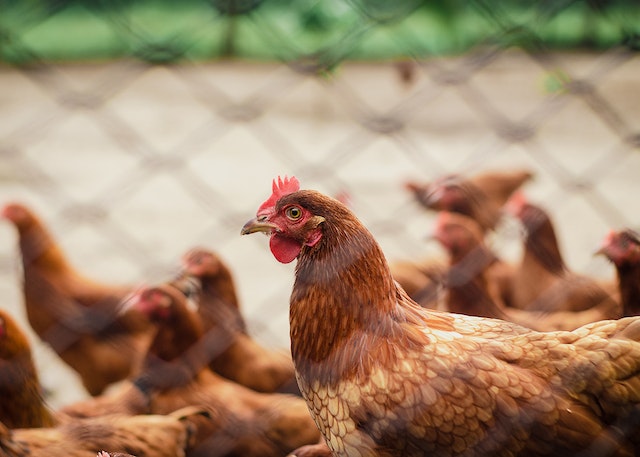
When did people start eating chickens? People have eaten chickens for thousands of years, but it only became cheap after World War 2.
Chickens were domesticated between 10,000 and 7,000 years ago in southeast Asia. The wild chicken that people domesticated was the Southeast Asian Red Junglefowl. They were probably domesticated because of the eggs they laid rather than their meat. That and they could be kept easily without being competitive for human food. For the first few thousand years of the chicken-human relationship, chickens were used for egg laying and cock fighting. Cock fighting was so popular, that it is the main reason why chickens spread all over the world. People generally didn’t eat the meat because they were relatively more expensive to keep than other farm animals. Cattle and horses eat grass. Pigs eat anything, especially leftover food. Chickens have to be fed on grain, which costs more. Chickens are also more likely to be killed by weather, disease, or predators. On top of that, chickens have far less meat on them than a cow or a pig do. They were more valuable for their eggs than their meat. The cost of chickens at the time can be shown by the fact that people were actually buried with their chickens, along with other household goods.
In 1923, chicken in America cost almost $20 for a kilogram. Today, it costs about $4.5. The amount of chicken eaten every year has also drastically changed. In 1900, Americans ate an average of 4.5 kg of chicken a year. These days, Americans eat an average of 41 kg a year. Farmers kept chickens, but usually to lay eggs for their own families or local shops. Chickens were also much smaller and had far less meat. In 1920, the average chicken weighed a little over a kilogram. Today, the average chicken weighs about 3.5 kg. So, what changed? Why did people start to eat more chicken?
The jump in the amount of chicken eaten came after World War 2. There were many reasons for this, but it wouldn’t have been possible without Cecile Steel in 1923. She was a farmer in Delaware, US, and in 1923 she ordered 50 chicks. The company made a mistake and sent her 500. Instead of sending them back, she decided to raise them. She built a barn for them and raised them in a relatively small space with regular food. She kept raising more and more chickens until she had 30,000 chickens. She started to sell the chicken for meat and made a vast profit. She was the first person to industrially produce chicken for meat.
During World War 2, there was a huge shortage of beef and pork and the government looked around for other possible meats. They tasked the Department of Agriculture with finding a chicken that was large enough to feed a family and with less bone. They managed and they bred a chicken that was 40% heavier than regular chickens and reached full weight in 86 days. The government liked it, but people still wouldn’t buy chicken. The main problem with chicken was that it was sold whole, with all of the insides still inside. Housewives (who usually did the cooking) would have to prepare it before they cooked it and they didn’t really want to do all that work, so they didn’t buy it.
By this point, farmers had started to copy Cecile Steel’s method and chickens were being industrially farmed. More chickens were being grown in less space and, consequently, the price started to come down. Housewives still didn’t want to go to the trouble of cooking a chicken, but it gradually become slowly more popular. Then, in the 1970s, the chicken process was mechanized and prepared chicken was sold in supermarkets for the first time. The new processes meant it was quicker and easier to slaughter, defeather, and prepare a chicken, so the price came down again. Chicken was now much cheaper than beef and by 1992 sales of chicken had passed those of beef and pork in the USA.
Chicken may be cheap, but there are a lot of problems that come with that. Obviously, the conditions the chickens are kept in are pretty bad, but they are few antibiotics to keep them free of diseases. This is part of the reason why bacteria are slowly becoming immune to antibiotics. They are also fed growth hormones to make them bigger faster. After World War 2, it took 86 days for a chicken to reach full size. These days it only takes 47 days. That makes them more profitable, but it is not necessarily a good thing. And this is what I learned today.
Sources
https://en.wikipedia.org/wiki/Chicken_as_food
https://franchescasdawnfarm.com/blog/chicken-was-once-the-most-expensive-meat-what-happened
https://cluckin.net/how-much-did-chickens-and-poultry-supplies-cost-in-the-old-days.html
Photo by Italo Melo: https://www.pexels.com/photo/brood-of-hen-2446695/
